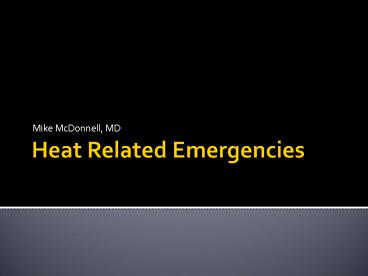Heat Related Emergencies - PowerPoint PPT Presentation
1 / 19
Title:
Heat Related Emergencies
Description:
mid August, 30 C with Humidex feels like 40 C ... Anhidrosis. Acute renal failure. Oliguria. cooling immediately is key to survival ... – PowerPoint PPT presentation
Number of Views:363
Avg rating:3.0/5.0
Title: Heat Related Emergencies
1
Heat Related Emergencies
- Mike McDonnell, MD
2
Scenario
- HUSAR team gets deployed to the collapse of an
office tower in downtown Toronto - people are trapped
- mid August, 30ºC with Humidex feels like 40ºC
- team member complains of cramps, stops working
and drinks, goes back to work - later found sitting in corner, staring, mumbling
about mummy
3
Objectives
- physiology of heat transfer/cooling
- heat related illnesses
- types
- Treatment
- on the pile vs. in the pile
4
Physiology of Heat Transfer
- Supply and Demand relationship
- Supply (heat production)
- BMR
- without cooling, temperature increases 1.1ºC/hr
- Increases up to 20X with strenuous exercise
5
Supply and Demand
- Demand (heat loss)
- Conduction
- warm body to cooler surroundings (2)
- Convection
- heat loss to air and water
- better with loose clothing, higher wind velocity
- Radiation
- electromagnetic waves
- great in cool temperatures, net gain when warm
- Evaporation
- conversion of liquid to gas
- major factor non-acclimatized sweat 1
litre/hour - not effective when relative humidity gt75
6
Physiology of cooling
We are like a water cooled car....
7
Heat Related Illnesses
- Spectrum
- Not so bad, bad, very bad
8
Not so bad
- Prickly Heat
- obstruction of the sweat gland pores, produces
vesicles, sometimes ruptures, very itchy - can get superinfected/rupture
- treated with chlorhexidine, antibiotic creams,
loose clothing preventative
9
Not so bad
- Heat edema
- nonacclimatized individuals
- standing for long periods of time
- affects feet and ankles
- treated with leg elevation
10
Not so bad
- Heat Cramps
- brief, intermittent, severe cramps in working
muscles - early on in work in hot environment
- heavy sweaters with hypotonic fluid replacement
more at risk - usually after exertion
- treatment
- Rapid elevation of salt solutions ½ tsp salt in
quart of water, commercially available solutions
taste better
11
Bad
- Heat Syncope
- vasodilation and venous pooling from standing
- reduced circulating blood volume
- volume loss makes it worse
- elderly are more susceptible
- treatment fix causes/injuries
12
Bad
- Heat Exhaustion
- volume depletion under heat stress
- two types water and salt depletion
- water inadequate fluid replacement
- salt hypotonic fluid replacement
13
Heat Exhaustion
- Signs and Symptoms
- vague malaise, fatigue, headache
- core temperature often normal if elevated, less
than 40 C (104 F) - mental function essentially intact no coma or
seizures - tachycardia, orthostatic hypotension, clinical
dehydration (may occur) - other major illness ruled out
- if in doubt, treat as heat stroke
14
Heat Exhaustion - Treatment
- rest
- cool environment
- assess volume status
- fluid replacement normal saline to replete
volume if patient orthostatic, replace free water
deficits slowly to avoid cerebral edema
15
Very Bad
- Heat Stroke
- Hallmark alteration in level of consciousness
- thermoregulation is overwhelmed and fails
- may be a prodrome, may be like heat exhaustion
- rapid treatment is essential
16
Heat Stroke
- Diagnosis
- exposure to heat stress
- signs of severe CNS dysfunction (coma, seizures,
delirium) - core temperature usually above 40.5 C (105 F),
but may be lower - dry, hot skin common, but sweating may persist
17
Types
- Classic and exertional
18
Treatment
- cooling immediately is key to survival
- use all methods of heat transfer
- spraying atomized cool water (evaporation)
combined with fans (convection) very effective - ice water immersion can be attempted
- rapid but take out when body temp lt 39ºC
- ice packs/cooling blankets less effective
19
Complications
- aspiration and seizures are common
- airway control
- tachyarrhythmias are common
- usually resolve with cooling
- dont over hydrate (IV fluids) pulmonary edema
- agitation benzodiazepines
- shivering chlorpromazine, Demerol?

